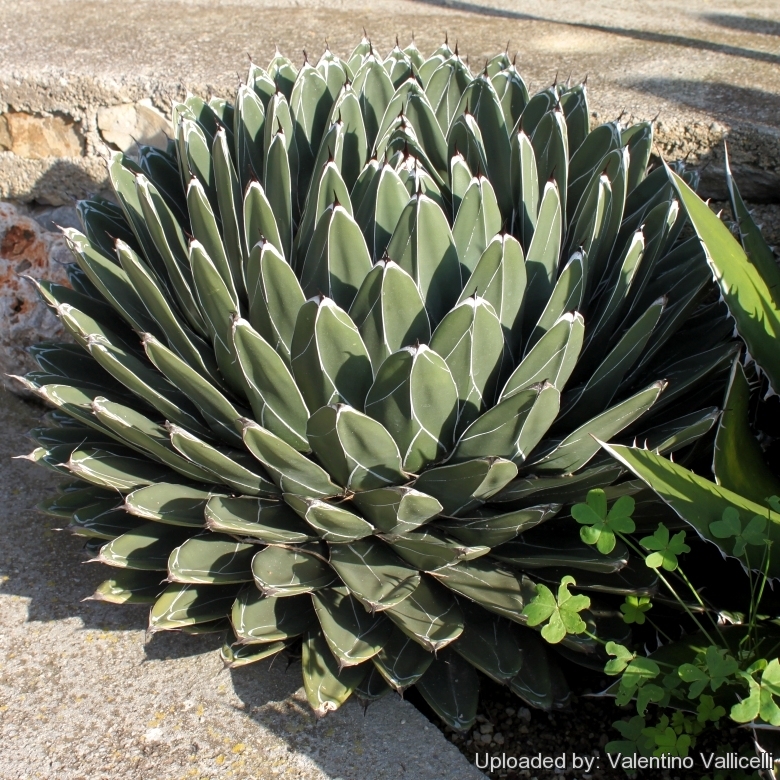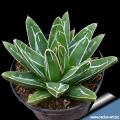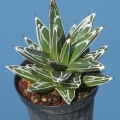
Agave victoriae-reginae Photo by: Valentino Vallicelli
Origin and Habitat: It is endemic to the arid lower elevations of the Sierra Madre Oriental Mountains in the state of Coahuila and south of Nuevo Leon in north-eastern Mexico (Huasteca canyon, Sierras de las Noas, Viesca, and adjacent areas just south of Saltillo).
Habitat: It grows mainly in calcareous soil characterised by a desert or semi-desert environment and is found in profusion on the steep slopes and near vertical cliffs of the canyon walls where forms large colonies. It is often associated with Hechtia sp. a genus of bromeliads which we often found growing with cacti.
While Agave victoria-reginae remains endangered in its native habitat, it has become very common in cultivation.
Synonyms:
See all synonyms of Agave victoriae-reginae
Common Names include:
ENGLISH: Royal Agave, Queen Victoria Agave
CHINESE (中文): 厚葉龍舌蘭, 鬼脚掌
DUTCH (Nederlands): Dronning Victoria-Agave
ESTONIAN (Eesti): Viktooria agaav
FINNISH (Suomi): Kruunuagaave
FRENCH (Français): Agave de la reine Victoria
GERMAN (Deutsch): Königs-agave
ITALIAN (Italiano): Agave della Regina Vittoria
JAPANESE (日本語): 笹の雪
LITHUANIAN (Lietuvių): Karališkoji agava
PORTUGUESE (Português): Agave-vitória-régia
RUSSIAN (Русский): Агава королевы Виктории
SPANISH (Español): Agave de la reina Victoria, Noa, Agave Reina Victoria, Pintillo, Noha
SWEDISH (Svenska): Drottningagave
UKRAINIAN (Українська): Агава королеви Вікторії
Description: A. Victoria-reginae is a very slow growing but tough and beautiful Agave. It is consider the to be one of the most beautiful and desirable species. It is extremely variable with the very open black-edged form sporting a distinct name (King Ferdinand's agave, Agave ferdinandi-regis) and several forms that are the more common white-edged form. Several cultivars have been named with different patterns of white leaf markings or no white markings (var. viridis) or white or yellow variegation.
Rosettes: Individual or sukering, slow growing, dense, up to 45 cm in diameter (but usually rarely grows taller than 22 cm), most populations are solitary, but some offset heavily (forma caespitosa and forma stolonifera).
Leaves: Short,15-20 cm long and up to 3 cm broad, rigid and thick, trigonous, dark green, and beautifully marked with brilliant white-margins (The distinct longitudinal white markings are unique, slightly raised, like mini-variegation bordering each leaf) They are toothless, with only a short black, terminal spine. Leaves grow close together and are arranged in globose regular rosettes.
Flower: The inflorescence takes the form of a spike, from 2 to 4 metres high, containing many paired flowers of various colours, often with shades of purple red.
Blooming season: Summer. As with all types of Agave it have a long life cycle and sets flowers after approximately 20 to 30 years of vegetative growth, and the effort to produce the flowers exhausts the plant which dies within a short time.
Subspecies, varieties, forms and cultivars of plants belonging to the Agave victoria-reginae group complex
Bibliography: Major references and further lectures.
1) J. Thiede: Agavaceae. In: Urs Eggli “Illustrated Handbook of Succulent Plants: Monocotyledons: Monocotyledons” Springer Science & Business Media, 17/Jul/2001
2) A. Berger: “Die Agaven” Gustav Fischer Verlag Stuttgart. 1915
3) Wikipedia contributors. "Agave victoriae-reginae" Wikipedia, The Free Encyclopedia. Wikipedia, The Free Encyclopedia, 30 Jan. 2014. Web. 4 Nov. 2014.
4) San Marcos Growers contributors “Agave victoriae-reginae - Queen Victoria Agave ” San Marcos Growers <http://www.smgrowers.com>. Web. 27 Sep. 2014.
5) Howard Scott Gentry, “Agaves of Continental North America” (University of Arizona Press, 1982) pp. 183–185
6) “Agave victoriae-reginae” in: Moore, Thomas. Gardeners' Chronicle, new series 4: 485. 1875.
7) August J. Breitung: “Agave victoriae-reginae.” In: “The Agaves.” The Cactus & Succulent Journal Yearbook, pp 26–27.1968,
8) Thomas Heller: “Agave victoriae-reginae.” In: “Agaven.” 2. erweiterte Auflage, Münster 2006.
9) Mary Irish, Gary Irish: “Agave victoriae-reginae.” In: “Agaves, Yuccas, and Related Plants: A Gardener's Guide.” Timber Press, 2000,
10) Bernd Ullrich: “Agave victoriae-reginae T. Moore”. In: Kakteen und andere Sukkulenten. 41:7 plate 22.1990
 Agave victoria-reginae, Huasteca canyon, Santa Catarina, Monterrey, Nuevo Leon. Photo by: Amante Darmanin
Agave victoria-reginae, Huasteca canyon, Santa Catarina, Monterrey, Nuevo Leon. Photo by: Amante Darmanin Agave victoriae-reginae Photo by: Julio C. García
Agave victoriae-reginae Photo by: Julio C. García Agave victoriae-reginae Photo by: Valentino Vallicelli
Agave victoriae-reginae Photo by: Valentino Vallicelli Agave victoria-reginae, Huasteca canyon, Santa Catarina, Monterrey, Nuevo Leon. Photo by: Amante Darmanin
Agave victoria-reginae, Huasteca canyon, Santa Catarina, Monterrey, Nuevo Leon. Photo by: Amante Darmanin Agave victoria-reginae, Huasteca canyon, Santa Catarina, Monterrey, Nuevo Leon. Photo by: Amante Darmanin
Agave victoria-reginae, Huasteca canyon, Santa Catarina, Monterrey, Nuevo Leon. Photo by: Amante Darmanin Agave victoriae-reginae. Flowers. Photo by: Frikkie Hall
Agave victoriae-reginae. Flowers. Photo by: Frikkie Hall Agave victoriae-reginae. Seedlings. Photo by: Frikkie Hall
Agave victoriae-reginae. Seedlings. Photo by: Frikkie Hall Agave victoriae-reginae Photo by: Cactus Art
Agave victoriae-reginae Photo by: Cactus ArtCultivation and Propagation: It requires well-drained soil and light shade to full sun exposure, but they prefer some afternoon shade during the hottest summer month to avoid being fried by sun. It should be kept rather dry in winter or dormant season with minimum temperatures above zero in order to obtain good results, but it will tolerate quite low temperatures ( -10° C), particularly when dry. To give this marvellous plant vigour and life, water well during spring and summer and let it become barely moist between waterings. Along the coast or in areas where there are no frosts, these plants may be cultivated with success outdoors where their beauty is better observed. In cold climates it is adviseable to cultivate these plants in pots in order to protect them during the winter in dry, fresh rooms. Requires good ventilation and avoid over-watering.
Fertilizer: Feed only twice a year, once in April and once in July with a water-soluble potassium-rich fertilizer.
Plant Pests: Prone to mealy bugs and scale. Always inspect any new plant for pests before introducing it to your home or greenhouse.
Propagation: It reproduces thanks to the seeds or by the suckers produced at the base of the stems in the spring. Propagate them in evenly moist soil, mist occasionally and keep in filtered sunlight until they are growing.
Uses: These plants were discovered by the Spaniards in the 17th century where the local Indians used them for fibres, food and to make an alcoholic drink like Tequila. The fibres were used to make clothing and ropes. Most of the plant was used for food, raw and cooked. Flowering stems and flowers are edible and were roasted or boiled.
Your Photos

by Cactus Art

by Cactus Art

by Valentino Vallicelli

by Valentino Vallicelli























